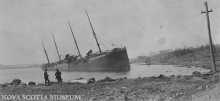As we can tell from CNN’s constant coverage of the Costa Concordia wrecked off of the Italian coast this week, we are nothing if not obsessed with shipwrecks. Certainly the Costa’s wreck is a tragedy with more than eleven people presumed dead, but it is also a very visible reminder of nature’s constant control of human invention. It’s been entirely eerie to see the huge Italian ship jutting out of the water with the rescue boats dotted around it looking small and insignificant. But the Costa Concordia’s casualty rate makes it nowhere near one of the greatest maritime tragedies in history. Let’s take a look at some of the most tragic shipwrecks during which nature asserted her unyielding power:
S.S. Eastland. The S.S. Eastland was touring ship that took passengers on expeditions around Chicago. In 1915, the S.S. Eastland was commissioned to take employee’s of the Western Electric Company to a picnic in Indiana. Perhaps because of the Titanic’s missing lifeboats, Woodrow Wilson had recently required the ship to carry enough life boats for the passengers, but that many boats made the Eastland unstable. As too many passengers moved to the port side of the boat, it tipped over on its side, crushing and trapping many people on the lower decks. Despite being on 20-feet from shore, 845 died of the 2752 passengers onboard.
MS Estonia. In 1994, the MS Estonia was on its way from Tallinn, Estonia to Stockholm, Sweden with 989 people aboard. The ship scratched another metal object around the Turku archipelago, but on inspection, no damage was discovered. Later, however, the ship fell starboard, trapping people in doorways and hallways and making it almost impossible to make it to the decks to escape on lifeboats. By this time, the boat had lost power, so it could not communicate its location to nearby ships, severely slowing down the rescue process. Only 137 of the ship’s passengers were saved.
RMS Empress of Ireland. In 1914, the RMS Empress of Ireland left Quebec City for Liverpool on the Saint Lawrence River. On the morning of May 29, the ship was travelling in heavy fog when a Norwegian boat called Storstad crashed into the ship. The Storstad was fine, but the Empress of Ireland sank in 14-minutes, killing 1012 of the 1,477 passengers and crew members aboard. Amazingly, a crew member who survived the sinking of the Titanic, the Lusitania and the sinking of this ship.
